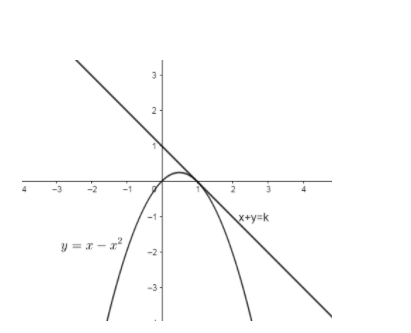
The straight line x + y = k touches the parabola, \[y=x-{{x}^{2}}\], if k =
(a) 0
(b) -1
(c) 1
(d) None of these
Answer
590.4k+ views
Hint: First of all write x + y = k as y = k – x. Then, from both equations we can equate y and get a quadratic equation. Since the line touches the parabola, the roots will be equal and so we know that the discriminant of the quadratic equation will be zero. Hence we can substitute and get the value of k.
Complete step-by-step answer:
We have been given the equation of a straight line as x + y = k.
The equation of parabola is \[y=x-{{x}^{2}}\]. Thus we can say that x + y = k is tangent of parabola, \[y=x-{{x}^{2}}\].

Now let us find the point of contact. For that we have to substitute either x or y in terms of y or x respectively and k from the equation of the line in the equation of the parabola.
x + y = k – (1)
\[y=x-{{x}^{2}}\]- (2)
From (1), we can say that, y = k – x.
Now let us equate both expressions on y.
k – x = \[x-{{x}^{2}}\]
Let us rearrange the expression,
\[\Rightarrow {{x}^{2}}-2x+k=0\] - (3)
Now the above equation is similar to the quadratic equation’s general form, \[a{{x}^{2}}+bx+c=0\] - (5).
We have been told that the straight line touches the parabola, then the roots are equal. Thus when roots are equal, the discriminant of quadratic formula will be zero. i.e. D = 0.
Which means that, \[{{b}^{2}}-4ac=0\] - (5)
By comparing (3) and (4), we get
a = 1, b = -2 and c = k.
Hence let us put these values in (5).
\[\begin{align}
& {{\left( -2 \right)}^{2}}-4\times 1\times k=0 \\
& \Rightarrow 4-4k=0 \\
& \therefore 4=4k \\
\end{align}\]
i.e. we get, \[k=\dfrac{4}{4}=1\].
Thus we got the value of k = 1.
\[\therefore \] Option (c) is the right answer.
Note: When a, b and c are real numbers, \[a\ne 0\] and the discriminant is zero, then the roots of the quadratic equation are real and equal. The discriminant of the resulting quadratic is zero, then the line is tangent to the parabola. One can also think of rearranging the first equation as x = k – y and then substituting in the second equation. This is also possible, but it will complicate the whole solution and will be more time consuming.
Complete step-by-step answer:
We have been given the equation of a straight line as x + y = k.
The equation of parabola is \[y=x-{{x}^{2}}\]. Thus we can say that x + y = k is tangent of parabola, \[y=x-{{x}^{2}}\].

Now let us find the point of contact. For that we have to substitute either x or y in terms of y or x respectively and k from the equation of the line in the equation of the parabola.
x + y = k – (1)
\[y=x-{{x}^{2}}\]- (2)
From (1), we can say that, y = k – x.
Now let us equate both expressions on y.
k – x = \[x-{{x}^{2}}\]
Let us rearrange the expression,
\[\Rightarrow {{x}^{2}}-2x+k=0\] - (3)
Now the above equation is similar to the quadratic equation’s general form, \[a{{x}^{2}}+bx+c=0\] - (5).
We have been told that the straight line touches the parabola, then the roots are equal. Thus when roots are equal, the discriminant of quadratic formula will be zero. i.e. D = 0.
Which means that, \[{{b}^{2}}-4ac=0\] - (5)
By comparing (3) and (4), we get
a = 1, b = -2 and c = k.
Hence let us put these values in (5).
\[\begin{align}
& {{\left( -2 \right)}^{2}}-4\times 1\times k=0 \\
& \Rightarrow 4-4k=0 \\
& \therefore 4=4k \\
\end{align}\]
i.e. we get, \[k=\dfrac{4}{4}=1\].
Thus we got the value of k = 1.
\[\therefore \] Option (c) is the right answer.
Note: When a, b and c are real numbers, \[a\ne 0\] and the discriminant is zero, then the roots of the quadratic equation are real and equal. The discriminant of the resulting quadratic is zero, then the line is tangent to the parabola. One can also think of rearranging the first equation as x = k – y and then substituting in the second equation. This is also possible, but it will complicate the whole solution and will be more time consuming.
Recently Updated Pages
A man running at a speed 5 ms is viewed in the side class 12 physics CBSE

State and explain Hardy Weinbergs Principle class 12 biology CBSE

Which of the following statements is wrong a Amnion class 12 biology CBSE

Two Planoconcave lenses 1 and 2 of glass of refractive class 12 physics CBSE

The compound 2 methyl 2 butene on reaction with NaIO4 class 12 chemistry CBSE

Bacterial cell wall is made up of A Cellulose B Hemicellulose class 12 biology CBSE

Trending doubts
What are the major means of transport Explain each class 12 social science CBSE

Which are the Top 10 Largest Countries of the World?

Draw a labelled sketch of the human eye class 12 physics CBSE

State the principle of an ac generator and explain class 12 physics CBSE

Sketch the electric field lines in case of an electric class 12 physics CBSE

Give 10 examples of unisexual and bisexual flowers




